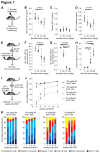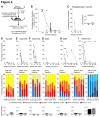Signal one and two blockade are both critical for non-myeloablative murine HSCT across a major histocompatibility complex barrier
- PMID: 24147041
- PMCID: PMC3798400
- DOI: 10.1371/journal.pone.0077632
Signal one and two blockade are both critical for non-myeloablative murine HSCT across a major histocompatibility complex barrier
Abstract
Non-myeloablative allogeneic haematopoietic stem cell transplantation (HSCT) is rarely achievable clinically, except where donor cells have selective advantages. Murine non-myeloablative conditioning regimens have limited clinical success, partly through use of clinically unachievable cell doses or strain combinations permitting allograft acceptance using immunosuppression alone. We found that reducing busulfan conditioning in murine syngeneic HSCT, increases bone marrow (BM):blood SDF-1 ratio and total donor cells homing to BM, but reduces the proportion of donor cells engrafting. Despite this, syngeneic engraftment is achievable with non-myeloablative busulfan (25 mg/kg) and higher cell doses induce increased chimerism. Therefore we investigated regimens promoting initial donor cell engraftment in the major histocompatibility complex barrier mismatched CBA to C57BL/6 allo-transplant model. This requires full myeloablation and immunosuppression with non-depleting anti-CD4/CD8 blocking antibodies to achieve engraftment of low cell doses, and rejects with reduced intensity conditioning (≤75 mg/kg busulfan). We compared increased antibody treatment, G-CSF, niche disruption and high cell dose, using reduced intensity busulfan and CD4/8 blockade in this model. Most treatments increased initial donor engraftment, but only addition of co-stimulatory blockade permitted long-term engraftment with reduced intensity or non-myeloablative conditioning, suggesting that signal 1 and 2 T-cell blockade is more important than early BM niche engraftment for transplant success.
Conflict of interest statement
Figures




Similar articles
-
Apoptotic donor leukocytes limit mixed-chimerism induced by CD40-CD154 blockade in allogeneic bone marrow transplantation.Biol Blood Marrow Transplant. 2006 Dec;12(12):1239-49. doi: 10.1016/j.bbmt.2006.08.038. Biol Blood Marrow Transplant. 2006. PMID: 17162205
-
Allogeneic stem cell transplantation using myeloablative and reduced-intensity conditioning in patients with major histocompatibility complex class II deficiency.Biol Blood Marrow Transplant. 2010 Jun;16(6):818-23. doi: 10.1016/j.bbmt.2010.01.002. Epub 2010 Jan 14. Biol Blood Marrow Transplant. 2010. PMID: 20079864
-
Bone Marrow Graft-Versus-Host Disease in Major Histocompatibility Complex-Matched Murine Reduced-Intensity Allogeneic Hemopoietic Cell Transplantation.Transplantation. 2017 Nov;101(11):2695-2704. doi: 10.1097/TP.0000000000001733. Transplantation. 2017. PMID: 28319565
-
Hematopoietic cell transplantation for the induction of allo- and xenotolerance.Clin Transplant. 1996 Aug;10(4):357-63. Clin Transplant. 1996. PMID: 8884109 Review.
-
Alloreactivity as therapeutic principle in the treatment of hematologic malignancies. Studies of clinical and immunologic aspects of allogeneic hematopoietic cell transplantation with nonmyeloablative conditioning.Dan Med Bull. 2007 May;54(2):112-39. Dan Med Bull. 2007. PMID: 17521527 Review.
Cited by
-
Interferon induced protein 35 exacerbates H5N1 influenza disease through the expression of IL-12p40 homodimer.PLoS Pathog. 2018 Apr 26;14(4):e1007001. doi: 10.1371/journal.ppat.1007001. eCollection 2018 Apr. PLoS Pathog. 2018. PMID: 29698474 Free PMC article.
-
Heparan sulfate inhibits hematopoietic stem and progenitor cell migration and engraftment in mucopolysaccharidosis I.J Biol Chem. 2014 Dec 26;289(52):36194-203. doi: 10.1074/jbc.M114.599944. Epub 2014 Oct 30. J Biol Chem. 2014. PMID: 25359774 Free PMC article.
-
Strategies for the Induction of Immune Tolerance to Enzyme Replacement Therapy in Mucopolysaccharidosis Type I.Mol Ther Methods Clin Dev. 2019 Mar 2;13:321-333. doi: 10.1016/j.omtm.2019.02.007. eCollection 2019 Jun 14. Mol Ther Methods Clin Dev. 2019. PMID: 30976609 Free PMC article.
-
Non-genotoxic conditioning facilitates hematopoietic stem cell gene therapy for hemophilia A using bioengineered factor VIII.Mol Ther Methods Clin Dev. 2021 May 5;21:710-727. doi: 10.1016/j.omtm.2021.04.016. eCollection 2021 Jun 11. Mol Ther Methods Clin Dev. 2021. PMID: 34141826 Free PMC article.
References
-
- Wynn RF, Wraith JE, Mercer J, O'Meara A, Tylee K et al. (2009) Improved metabolic correction in patients with lysosomal storage disease treated with hematopoietic stem cell transplant compared with enzyme replacement therapy. J Pediatr 154: 609-611. doi:10.1016/j.jpeds.2008.11.005. PubMed: 19324223. - DOI - PubMed
Publication types
MeSH terms
Substances
LinkOut - more resources
Full Text Sources
Other Literature Sources
Research Materials
Miscellaneous

